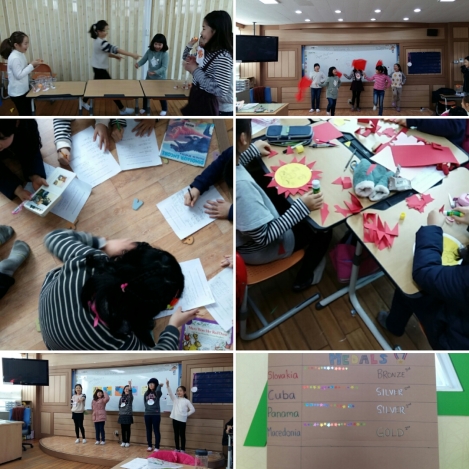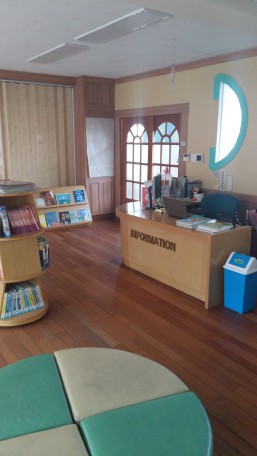I apologize for the lack of posting these past couple weeks. If you were wondering where I was… English camp had taken over my life! I even forgot what month we were in. As I looked at my calendar, I thought holy crap, I’ve been teaching in Korea for almost a YEAR now!

So let’s rewind to day one… when it all began…
(Cue dream music)
It’s the first day of school. The bell rings. Twenty cute Korean third graders come prancing into the room. Suddenly, all eyes are on me: the foreigner, the “waygook”, their new English teacher. Nervous as hell, I start my introductory lesson.
Good morning class! I say in the most cheerful way possible; my voice rising like three octaves above my normal voice.
Three, maybe four students respond to my overly cheerful greeting.
Yeesh, tough crowd.
Well, I don’t dwell on that too much. It’s the morning. Kids are probably still trying to wake up.
Luckily, I had my Korean co-teacher there to introduce me. As she’s speaking, their eyes are glued to me; curious to know what I’m all about. So I proceeded to show them my PowerPoint presentation about ‘Samantha Teacher’ – a collection of photos from my life in Canada. And of course I added the Biebs in there for cultural reference (he was big in Asia during his pre teen days). I got a few ‘oohs’ and ‘ahhs’ from the crowd. The children slowly started to warm up to this stranger in their classroom.
Please like me, please like me, please like me. It was like I was in Mean Girls, waiting to be accepted by Regina George.
After my little slideshow, it was time to teach the lesson.
Before you know it, the forty minutes was up and the next batch of kids was coming through the door. Ready to repeat the awkward introduction all over again…
Fast forward ten months later and here I am, gearing up for week two of my Olympics-themed English camp.

Many people think that teaching is an easy job – you just get up and read some words from the text book and that’s it! Uh…think again! There is far more to teaching than that. And if you are one of those people who stand up at the front and read, just…don’t. You have to be quick on your feet and ready to shift the lesson at any moment. These kids really are the ones who run the show. I’ve found that students can either be very receptive to the lesson or they can make those forty minutes a living hell. Disaster classes can and WILL happen.
But fear not! I have some tips that may help alleviate any anxieties that will come with teaching abroad.
- Plan, plan, plan
Luckily, this comes natural for me – I’ve always been an organized person (well, planning was my job before coming to Korea so I better be good at it!). When it comes to teaching, you NEED to plan what you want to do for the lesson with a goal in mind. What do you want the kids to achieve by the end of the class? Write this down whether it’s with a formal lesson plan format or basic bullet notes on a paper. Just make sure you stay organized! Planning 22 classes per week can get crazy.
- Become a pro at PowerPoint
There is SO much you can do with PowerPoint – I’m still navigating the ins and outs to create awesome English activities for my students. If you’ve taken a class in school or elsewhere, good on ya! If you are a novice to the PPT world, don’t fret! There are lots of online tutorials to get you comfortable with PowerPoint (as well as other programs like Excel, and Adobe Creative Suites). Check out Lynda.com for these great tutorials. You’ll be a wiz in no time!

- Keep calm and teach on
Whatever you do, don’t freak out. Sometimes I feel a little discouraged when my lessons aren’t as successful as others. But I look at what went wrong, learn from it, and move on. I say that disaster lessons help if anything. You’ve got to ‘fail’ a little to succeed. If a game or activity wasn’t successful, then I probably won’t play it again in the future. Or if I do, I’ll make sure I change up the rules or adjust the English ability level. What’s good about public school is that I always have a Korean co-teacher in the room, assisting me with teaching duties, classroom management, and translation. This brings me to my next point…
- Establish good relations with your co-teacher
So I have three co-teachers (grades 3-4, 5, and 6) and I have great relationships with all three. They all speak very good English, especially my main co-teacher who picked me up from the bus station the day I arrived in Busan. She took me to the immigration office, helped me set up bank account and cell phone, and showed me around the town the first day! I owe my life to this woman. Having a good relationship with your co-teacher outside of the classroom will only benefit inside the classroom. All three of my co-teachers have different teaching styles which I have to adapt to when it’s time to teach with them. A few days before my classes, I will meet with them individually and we’ll put together the lesson plan for the week. Basically, just a bullet list of things we’ll do for those forty minutes. After the classes, we’ll debrief and talk about successes (and praise each other for it) and what we can do better for next time.

- Get on their level
When I am teaching my students the lesson content, I make sure to add in pop cultural references where I can. K-pop stars and cartoon/movie characters will make your PPTs much more interesting. It makes it easier for them to understand the content if it’s something that they can relate to. I also like to throw in some Canadian and American culture, too (I think my kids understand the word ‘dancing’ after watching Drake’s Hotline Bling GIF). Speaking of… GIFs will be your best friend. Make sure you have lots of these motion images in your PPTs. Looking for funny images to add to your PowerPoints? Check out Giphy – just make sure it’s appropriate for the children.

- Keep it simple (and slow down!)
This is something I’ve struggled with even when talking to native English speakers. I’ll blame my thousand-word essay writing days on that. Just keep it simple. Cut to the chase. Don’t add filler words. Also, slow down on the speech – this isn’t a race! If you’re talking a mile a minute with unnecessary words thrown in there, guaranteed the kids will NOT understand anything. This is why my last tip is the most important…

- Body language is everything
After teaching I think I should become a mime. Honestly, I don’t think I’ve been so animated in my life! Body language really helps when teaching, especially to children, who need those visuals more than anything. I’m pretty sure I have a motion for just about everything. The funniest is when I make something up on the fly in front of the class. They seem to get a kick out of that.
I wondered if teaching would get any easier, and I can happily tell you it has! It’s like with anything new you’ll experience in life: it may seem awkward and uncomfortable at first but once you’re familiar with it and have a routine going, it’s smooth sailing.

I’m looking forward to what my second year teaching will be like. That’s right… I’M STAYING IN KOREA FOR ANOTHER YEAR! Surprise!
For my fellow teachers out there, how has your teaching experience been? Whereabouts are you teaching? I would love to hear your thoughts in the comments section.
Happy teaching (& travels!)
S
Good read, glad that you’re enjoying what you do. Keep the posts coming, and enjoy year two ☺
LikeLike
Nice post. I agree with all of these 🙂
LikeLike
Reblogged this on Heba vs Reason.
LikeLike
What an excellent blog Sam! A really enjoyable read and full of great tips. May I add….. that you look like a little Korean teacher yourself in the pics. Keep up the good work. Can’t wait to read the next update on your life and time in Korea.
LikeLike
NOTED!haha
LikeLike
I spent a day in a thai elementary school it was pretty neat but I could see the chaos as well, great post!
LikeLike
Wow! took me back in time when I was seated in the front row of a classroom, shyly stealing glances at the the ‘new’ class teacher.great post, much appreciated.
Welcome to check out my site and give your valuable comments:
http://www.imvoyager.com
LikeLike
Hahaha, loving the fact that you threw the Biebs in there! Sounds like you settled in pretty quickly. These tips are great and super applicable for fellow teachers. Body language is so vital in most situations! Hope you’re enjoying your second year of teaching 🙂
Mel from illumelation.com x
LikeLike
Loved it! It is very helpful given the fact I will be joining as a teacher soon..very nervous..
LikeLike
Great points!!
I had a feeling you would stay another year!
Happy almost winter vacation!!!! 🙂
LikeLike
What you’re doing is great. Keep it up!
LikeLike
Oh my gosh this brings me back to my first day teaching in Spain! I remember walking in with all eyes on me and no English at all….teachers, students, and administration couldn’t stop staring haha. Powerpoint and I got to be best buds. Hangman was always my backup game…the loved it! Although only a few were good enough to guess the words in English. Wow, I miss it so much – so glad you’re staying for another year…I wish I had done it a second year!
LikeLike
I love this! I’m studying to be a teacher and think it’s awesome that you are sharing your knowledge in a Korean classroom. These are some great tips for teachers to remember. Congrats for your 1 year anniversary teaching and safe travels!
LikeLike
I think that what you’re doing is so brave and motivational! Great post, looking forward to reading more 🙂
LikeLike
Hey Samantha. I actually came across your blog before and I love it. I teach English in Japan and lots of the points you`ve raised can be used in Japan too!
In Japan schools don`t tend to use much technology belive it or not. In my school we still use a fax machine and teachers only got laptops this year! Also most teachers can`t speak English at all. i don`t know what`s going on half the time!
LikeLike
Hey girl- just wanted to say loved the post…you know, one blogger to another! Us expats in Korea gotta give each other dabs 🙂
LikeLike
Love it! You’re so passionate about teaching 🙂 Sometimes I can get a bit demotivated because few of my cos speak English, needed this little burst of positive energy! x
LikeLike